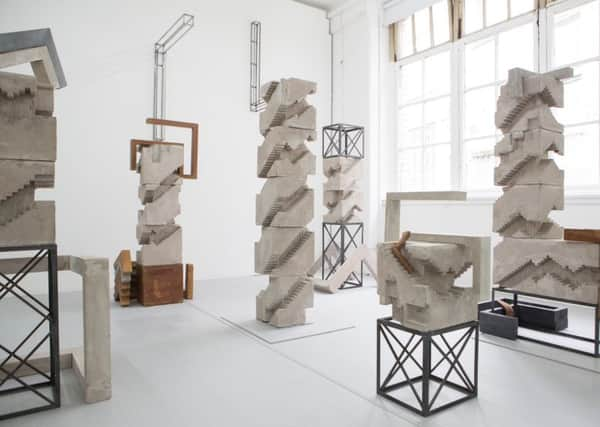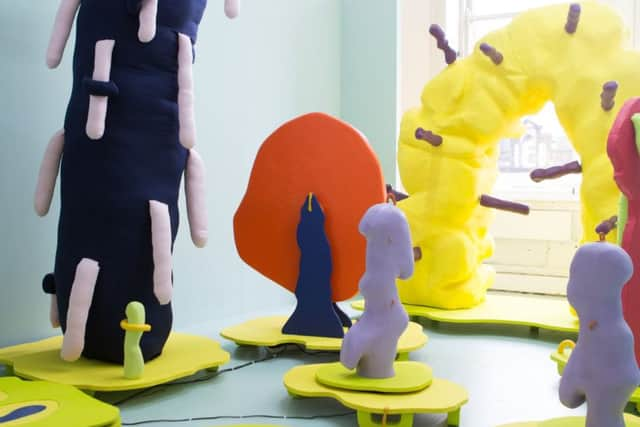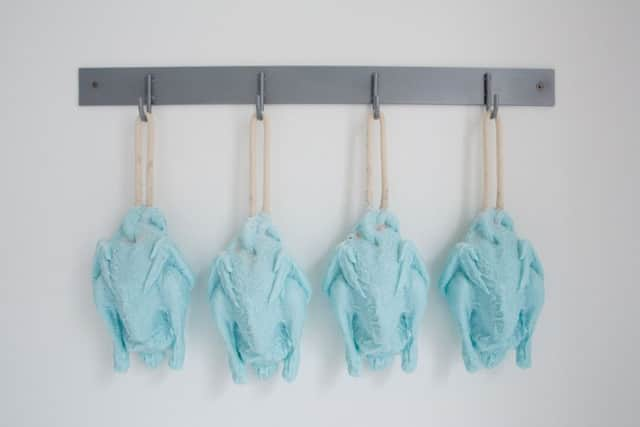Art review: Glasgow School of Art Degree Shows


The undergraduate work is laid out in blocks according to disciplines: Painting & Printmaking, Sculpture & Environmental Art and Fine Art Photography. Overall, while the work is ideas-driven, much making is in evidence, and to a high standard, from printmaking and filmmaking to knitting and creating objects out of metal. There is clearly a trend, also, for immersive environments which combine film, sound, objects, drawings and words. Around a dozen students use performance in their work, some of them creating elaborate environments in which to perform.
A degree show is a showcase: students – like the performing arts ingenues in The Kids from Fame – want us to remember their names. The GSA doesn’t help us here – the names are on the outside of each “stall”, in print so small as to be only just legible. One must continually refer to the (helpful) floorplan to identify each body of work. It’s harder still at the Glue Factory, where they don’t provide a floorplan.
Glasgow School of Art Degree Show 2017 ***


Tontine Building, Glasgow School of Art
MFA Degree Show 2017 ****
The Glue Factory, Glasgow
Advertisement
Hide AdAdvertisement
Hide AdOnly a tiny percentage of students provide a statement or any contextual material about their work. It’s a debate which continues to rage in contemporary art circles: shouldn’t the work speak for itself? Is it patronising to an audience to provide interpretive information? Does it disrupt or facilitate an audience’s experience of the work?


I think information is helpful, particularly when the (comparatively small) body of work on show is the culmination of years of study, and months – or years – of thinking and research. Our appreciation of the work is richer if we can understand something of the journey from “there” (research, interests, source material) to “here”. Providing none means there is a danger of perpetuating the myth that contemporary art is deliberately obscure and most of us are not smart enough to understand it.
That said, there is good work in this show which doesn’t need any explanation. Hannah Mooney’s still lives and landscape paintings look traditional, almost anachronistic, but she combines a modesty of approach with such evident skill that one is scarcely bothered. William Braithwaite’s sculptures of Escher-like staircases in concrete with metal embellishments, beams and frames, show a real feel for materials, and for balancing solidity and space. Emmett McSheffrey’s photographic portraits of men are another stand-out, though it isn’t clear why they are accompanied by bones.
Alice Hughes is engaged in a productive dialogue with modernism in her sculptures. Megan Wood’s expressive portraits of children from old photograph albums show a lot of promise. Matthew Buick’s photographs of spectators – at the zoo, at tourist attractions, peering through a fence – is a simple idea nicely realised.
Lea (Ye Gyoung) Choi’s performance, Coming Soon!, is a juxtaposition of ideas of science, marketing and the threat of war, spliced together with humour and a great deal of attention to detail. Tamara MacArthur’s installation looks like it might be a space for a performance, but also stands alone and demonstrates a real understanding of drawing the human figure.


Several students use their degree show work to explore issues of culture and identity between countries: Paisley Diamond looks at cultural appropriation from the point of view of a British person who looks Chinese, pointing out that some important customs associated with the Far East – including fortune cookies and the “lucky cat” – are actually largely Western inventions. Photographer Ben Soedira explores his relationship with Dubai, a city brought to life from “foreign” elements in the desert, and demonstrates a fine eye for tones and textures, as well as the potential for the specific to contain a discussion of bigger ideas. Holly Gavin grew up in Lebanon, and paints the colours and forms she associates with it, filtered through memory and sensation.
Some students in Sculpture and Environmental Art (SEA) are strongly committed to the Environmental Art principle of engagement: Lucy Wilkinson’s interviews with women footballers, displayed on football shirts in a changing room; Eleanor Jaroszynska’s proposal to build a community bread oven in Garnethill Park using stones from the Mackintosh Building. Others are dedicated sculptors with enough confidence in their skill to have a bit of fun: enjoy Millie Layton’s bright moving shapes, or Amy Grogan’s vegetables (the inflatable carrots and blue chickens are particular highlights).
Advertisement
Hide AdAdvertisement
Hide AdViolet Blyth and Maren E Nordheim (both Fine Art Photography) create immersive environments using objects, film, images and light, and invite us to spend time there considering the nature of perception and experience. Theodosia Hadjithekli has made a series of impressive photorealist paintings exploring the refugee situation in Greece, painting inanimate things instead of people, such as a “graveyard” of life jackets.
Meanwhile, the work of the MFA students raises the bar further (as it should) with an overall quality of execution that wouldn’t be out of place in any professional exhibition. It is well curated, with bodies of work emerging like glinting points of light in the grimy, post-industrial space of the Glue Factory. They are an international group, and a diverse one, ranging across disciplines. Sometimes there is diverse work even from the same individual. Julian Tolhurst crops up three times, with music composed electronically for solo cello, two painted panels which look like an abstracted Artex ceiling, and a film of himself “Eating clay on a sunny day”. Sabe Lewellyn does smells and bells – a rather beautiful installation of hanging bells, and a series of aromas which make the subtlest of interventions through the Glue Factory space.


Lauren Davis explores relationship to place through printed fabric on metal frames; Holly McLean has made a documentary film about her sister’s experience with a stalker; Tom Krasny investigates the little known history of the wartime internment of German civilians at Knockaloe on the Isle of Man, and their unexpected connection to a piece of Charles Rennie Mackintosh furniture.
A theatrical impulse runs through the MFA show: Michael Hautemulle’s sculpture – like a miniature scale model of a stage – is accompanied by a score from Wagner’s Siegfried and James Ó hAodha has made an engaging film of actors being put through their paces.
Jamie Limond arranges paintings into a kind of performance, placing each on a microphone stand and placing them like actors in the space.
As with the undergraduate show, there is much here to appreciate, although we might be able to appreciate it more if they were prepared to tell us a little about their journeys from “there” to “here”.
*Both shows run until 17 June